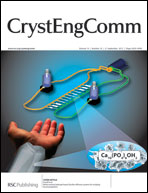Investigation of a new organic/inorganic hybrid crystal tri(p-chloro-anilium) pentabromocadmate(II) by in situPXRD and FTIR methods: Thermal stability and the route to suppress its decomposition†
Abstract
A new organic/inorganic hybrid crystal tri(p-chloro-anilium) pentabromocadmate(II) ((p-Cl-C6H4-NH3)3CdBr5) was grown by a programmed cooling method, and its structure was determined using an X-ray diffraction method. This hybrid crystal crystallizes in the monoclinic space group P21/c with unit cell parameters a = 15.033(2) Å, b = 8.0189(12) Å, c = 23.103(4) Å, β = 99.649(8)°, V = 2745.6(7) Å3, Z = 4, R[F2 > 2σ(F2)] = 0.0538, wR(F2) = 0.0833. The heating processes of the hybrid crystals were investigated by


 Please wait while we load your content...
Please wait while we load your content...